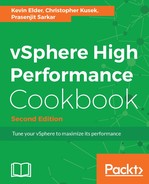A Virtual machine monitor (VMM) is a thin layer that provides a virtual x86 hardware environment to the guest operating system on a VM. This hardware includes a virtual CPU, virtual I/O devices, and timers. A VMM leverages key technologies in VMkernel, such as scheduling, memory management, and the network and storage stacks.
Each VMM is devoted to one VM. To run multiple VMs, VMkernel starts multiple VMM instances, also known as worlds. Each VMM instance partitions and shares the CPU, memory, and I/O devices to successfully virtualize the system. A VMM can be implemented using hardware virtualization, software virtualization (binary translation), or paravirtualization (which is deprecated) techniques.
Paravirtualization refers to the communication between the guest operating system and the hypervisor to improve performance and efficiency. The value proposition of paravirtualization is in lower virtualization overhead, but the performance advantage of paravirtualization over hardware or software virtualization can vary greatly depending on the workload. Because paravirtualization cannot support unmodified operating systems (for example, Windows 2000/XP), its compatibility and portability are poor.
Paravirtualization can also introduce significant support and maintainability issues in production environments because it requires deep modifications to the operating system kernel, and for this reason, it was most widely deployed on Linux-based operating systems.
